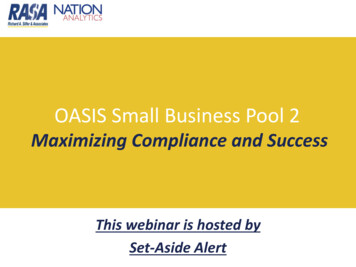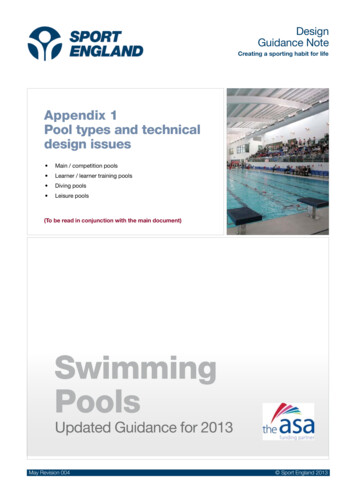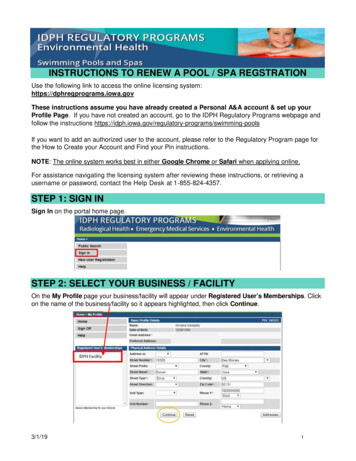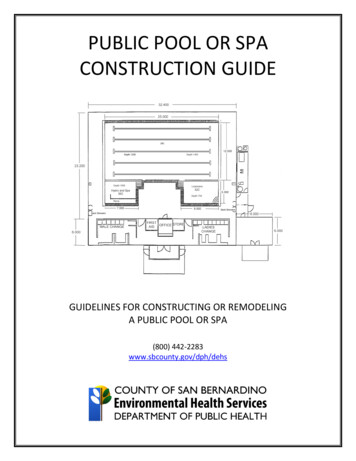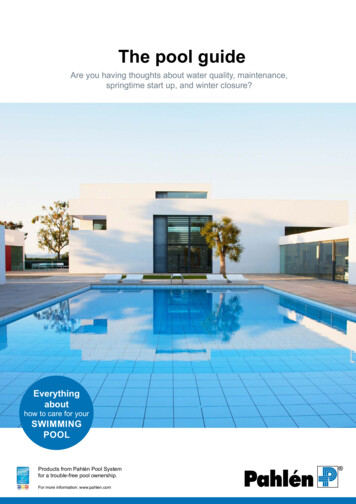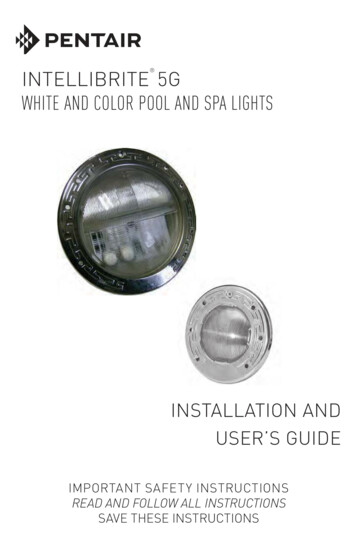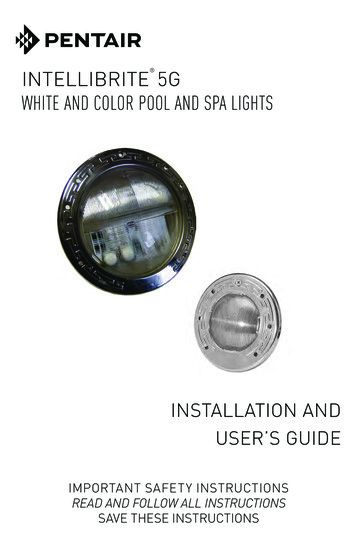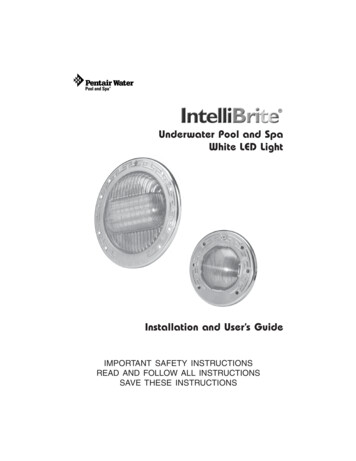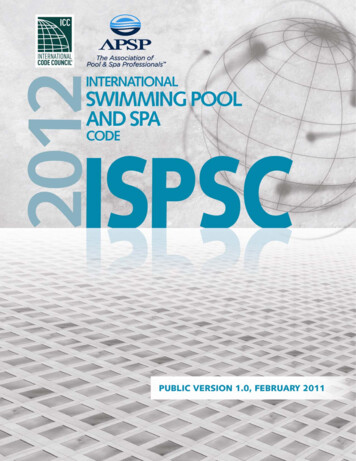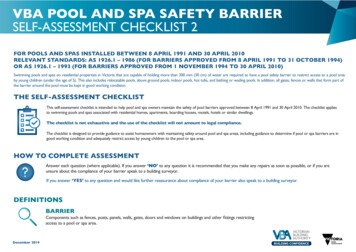
Transcription
VBAPOOLANDSAFETYVBA POOLANDSPA F-ASSESSMENT CHECKLIST2 2FOR POOLS AND SPAS INSTALLED BETWEEN 8 APRIL 1991 AND 30 APRIL 2010RELEVANT STANDARDS: AS 1926.1 – 1986 (FOR BARRIERS APPROVED FROM 8 APRIL 1991 TO 31 OCTOBER 1994)OR AS 1926.1 – 1993 (FOR BARRIERS APPROVED FROM 1 NOVEMBER 1994 TO 30 APRIL 2010)Swimming pools and spas on residential properties in Victoria that are capable of holding more than 300 mm (30 cm) of water are required to have a pool safety barrier to restrict access to a pool areaby young children (under the age of 5). This also includes relocatable pools, above ground pools, indoor pools, hot tubs, and bathing or wading pools. In addition, all gates, fences or walls that form part ofthe barrier around the pool must be kept in good working condition.THE SELF-ASSESSMENT CHECKLISTThis self-assessment checklist is intended to help pool and spa owners maintain the safety of pool barriers approved between 8 April 1991 and 30 April 2010. The checklist appliesto swimming pools and spas associated with residential homes, apartments, boarding houses, motels, hotels or similar dwellings.The checklist is not exhaustive and the use of the checklist will not amount to legal compliance.The checklist is designed to provide guidance to assist homeowners with maintaining safety around pool and spa areas, including guidance to determine if pool or spa barriers are ingood working condition and adequately restrict access by young children to the pool or spa area.HOW TO COMPLETE ASSESSMENT?Answer each question (where applicable). If you answer ‘NO’ to any question it is recommended that you make any repairs as soon as possible, or if you areunsure about the compliance of your barrier speak to a building surveyor.If you answer ‘YES’ to any question and would like further reassurance about compliance of your barrier also speak to a building surveyor.DEFINITIONSBARRIERComponents such as fences, posts, panels, walls, gates, doors and windows on buildings and other fittings restrictingaccess to a pool or spa area.December 2019
QUESTIONSYESNOSTEP 1 – BARRIERDIAGRAMOBJECTIVE: SWIMMING POOLS AND SPAS MUST BE SURROUNDED BY A BARRIER RESTRICTING UNSUPERVISED ACCESS BY YOUNG CHILDREN.a) If your pool or spa barrier was approved between8 April 1991 and 31 October 1994, completeSteps 2, 3 and 8.b) If your pool or spa barrier was approved between1 November 1994 and 30 April 2010, completeSteps 2 to 8.STEP 2 – FENCING (INCLUDING ASSOCIATED GATES)OBJECTIVE: FENCING MUST BE CONSTRUCTED AND MAINTAINED TO ENSURE THAT: it cannot be used as a climbing device for youngchildren to access the pool area; and no surfaces close to the fence can be used as aclimbing platform; and young children cannot climb under the fence to accessthe pool area.Is the pool fencing at least 1200 mm high?
QUESTIONSYESDIAGRAMNOINSIDEOUTSIDEIs the area around the outside of the fencing clear ofclimbable objects (e.g. furniture, toys, pot plants, BBQs)within a 1200 mm quarter circle measured from the top ofthe fence?(Refer to diagram)1200 mm min.CLEARSPACEFENCINGFINISHEDGROUND LEVEL450 mm min.If the fencing is constructed using perforated material ormesh with holes greater than 13 mm but less than 100 mm: is it at least 2400 mm high; or does it have a vertical section at least 1800 mm highwith a 450 mm cranked top above(Refer to diagram); and135 max.90 min.INSIDEdoes the fence have strainer wires or rails at the topand bottom?FINISHEDGROUND LEVEL1800 mmmin.OUTSIDE
QUESTIONSYESDIAGRAMNOAre horizontal elements, such as rails, rods, wires or bracing: on the outside of the fencing, or where the spacing ofthe vertical elements is between 10 mm and 100 mm,at least 900 mm apart (Refer to diagram); or on the outside of the fencing with: the spacing of the vertical elements notmore than 10 mm apart; and the upper surface of the projection orindentation sloping away from the pool byat least 60 degrees to the horizontal?Are adjacent vertical elements, such as rods, palings,wires or bracing, no further apart than 100 mm?(Refer to diagram)100 mm max.1200 mmmin.900 mmmin.1100 mmmin.100 mmmax.Are openings between the bottom of the fencing and thefinished ground level 100mm less?(Refer to diagram)If the spacing of vertical elements is greater than10 mm, are horizontal surfaces (such as BBQsor fixed seating) inside the fencing located atleast 300 mm away from the fencing?
QUESTIONSYESDIAGRAMNO10 mmmin.Are projections and indentations (potential footholds andhandholds) with a depth of 10 mm or more: spaced at least 900 mm apart, and at least1100 mm below the top of the barrier(Refer to diagram); or sloping away from the pool by at least 60 degreesto the horizontal?900 mm min.1200 mmmin.POOLAREAIndentions orprojections in1100 mmbrick or panelmin.walls must notexceed 10mmunless they are900mm apart.900 mmmin.900 mmmin.900 mmmin.If not less than 900mm apart theprojections andindentations can begreater than 10 mmdeep.INDENTATIONPROJECTIONSTEP 3 – GATES AND FITTINGSOBJECTIVE: ALL GATES MUST NOT BE ABLE TO BE OPENED BY YOUNG CHILDREN AND IF OPEN, DOORS AND GATES MUST RETURN TO THE CLOSEDPOSITION WHEN RELEASED.Do gates providing access to the pool area swingoutwards, away from the pool area?Are gates fitted with a self-closing device that will returnthem to the closed position and engage the latching devicefrom any position with a stationary start without usingmanual force?Are gates fitted with a self-latching device that willautomatically operate on closing of the gate and preventthe gate from being reopened without being manuallyreleased?Are the gate self-latching devices incapable of beingadjusted in operation or adjusted without the use of tools?
QUESTIONSYESNODIAGRAM450 mmmin.150 mmmin.Are gate latch and release devices: located at least 1500 mm above the finished groundlevel; or located at least 1400 mm above the highest lowerhorizontal rail, rod, wire or bracing; or shielded to prevent inadvertent opening fromoutside the barrier? (Refer to diagram)FENCEGATE100 mm max. between verticalsSTEP 4 – WINDOWS (APPLICABLE ONLY TO POOLS OR SPAS APPROVED FROM 1 NOVEMBER 1994 TO 30 APRIL 2010)OBJECTIVE: WINDOWS THAT FORM PART OF A BARRIER MUST NOT PROVIDE A PATHWAY INTO THE POOL AREA.Are all openable parts of a window: at least 2400 mm above the pool area; or 1200 mm above the internal floor; or between 900 mm and 1200 mm above the internalfloor, and the opening panel is fitted with a securelyfixed flyscreen; or not greater than 1200 mm above the floor, and theopenable portion of the window– is covered by bars or a mesh screen that canonly be removed using a tool(Refer to diagram); or is fixed; andopenings are sufficiently strong and rigid toprevent a 105 mm diameter object from beingable to pass through?BARS
QUESTIONSYESNODIAGRAMSTEP 5 – DOORSETS (APPLICABLE ONLY TO POOLS OR SPAS APPROVED FROM 1 NOVEMBER 1994 TO30 APRIL 2010)OBJECTIVE: ALL DOORS MUST NOT BE ABLE TO BE OPENED BY YOUNG CHILDREN AND IF OPEN, DOORS AND GATES MUST RETURN TO THE CLOSEDPOSITION WHEN RELEASED. YOUNG CHILDREN SHOULD NOT BE ABLE TO REACH AND OPEN THE DOOR BY CLIMBING USING NEARBY FOOTHOLDS.Are doors fitted with a self-closing device that returns thedoor to the closed position without using manual force?Are doors fitted with a self-latching device that willautomatically latch on closing of the door and prevent thedoor from being reopened without manual release, withthe release located inside the building at least 1500 mmabove the floor?Are all footholds on doors near the area of release lessthan 10 mm deep or less than 100 mm above the floor?
QUESTIONSYESDIAGRAMNOSTEP 6 – RETAINING WALLS (APPLICABLE ONLY TO POOLS OR SPAS APPROVED FROM1 NOVEMBER 1994 TO 30 APRIL 2010)OBJECTIVE: RETAINING WALLS MUST BE CONSTRUCTED SO THEY RESTRICT ACCESS BY YOUNG CHILDREN TO THE POOL AREA.FenceIf a retaining wall or similar structure forms part of thepool barrier on the high side of the pool, does: it have an effective height of at least 2400 mm; and; the outside surface have all projections and indentationsOUTSIDESURFACEwith a depth of 10 mm or more: spaced at least 900 mm apart and at least 1100mm below the top of the barrier; or the upper surface of the projection orindentation sloping towards the pool by atleast 60 degrees to the horizontal; and slope away from the pool by not more than 15 degreesto the vertical? (Refer to diagram)Effectiveheight2400 mm min.15 max.PoolFINISHEDGROUNDLEVELIf a retaining wall or similar structure forms part of thepool barrier on the low side of the pool, does it slopetowards the pool by not more than 15 degrees to thevertical, and:FencePool have an effective height of at least 1200 mm, and anoutside surface with all projections and indentationshaving a depth of 10 mm or more: spaced at least 900 mm apart and at least 1100mm below the top of the barrier; or the upper surface of the projection orindentation sloping away from the pool by atleast 60 degrees to the horizontal; or have an effective height of at least 2400 mm?(Refer to diagram)OUTSIDEEffectiveheight15 max.Finished ground level
QUESTIONSYESNODIAGRAMSTEP 7 – ABOVE GROUND POOLS (APPLICABLE ONLY TO POOLS APPROVED FROM 1 NOVEMBER1994 TO 30 APRIL 2010)OBJECTIVE: OBJECTS SUCH AS LADDERS, PUMPS AND FITTINGS MUST NOT BE ABLE TO BE USED AS A CLIMBING SURFACE TO ACCESS THE ABOVEGROUND POOL.Where the walls of the pool are used as a barrier, arethey at least 1200 mm high above ground level and dothey restrict climbing within a 1200 mm clear zone?STEP 8 – STRENGTH AND RIGIDITY OF FENCING COMPONENTS (INCLUDING DOOR SETSAND WINDOWS)OBJECTIVE: BARRIERS SHOULD NOT BE ABLE TO BE EASILY PUSHED OVER OR PHYSICALLY DAMAGED, REDUCING THE EFFECTIVENESS OF THE BARRIER.Is the strength and rigidity of the barrier sufficient to resistthe forces applied that could reasonably be expectedduring normal usage? This can be assessed by an averagesized adult pushing against the barrier at critical points (e.g.half way between vertical posts and the highest point ofthe barrier).
HELPFUL TIPSIf you answered ‘NO’ to any of the questions, here are some pointers to help you improve the safety of your pool or spa barrier. However, you shouldseek professional advice if you are unsure how to make your barrier safe and whether a building permit or other approvals are required.STEP 1 – BARRIERSWIMMING POOLS AND SPAS MUST BE SURROUNDED BY A BARRIER RESTRICTING UNSUPERVISED ACCESS BY YOUNG CHILDREN. If you do not have one of the barrier types listed, obtain a building permit to install a barrier that meets the current requirements. Contact your local council or an appropriately registered buildingpractitioner: you may search for one at www.vba.vic.gov.auSTEP 2 – FENCING (INCLUDING ASSOCIATED GATES)FENCING MUST BE CONSTRUCTED AND MAINTAINED TO ENSURE THAT: It cannot be used as a climbing device for young children to access the pool area; and No surfaces close to the fence can be used as a climbing platform; and Young children cannot climb under the fence to access the pool area. Install fencing to at least 1200 mm high. Remove all climbable objects (e.g. furniture, toys, pot plants, BBQs) from the clear space around the pool. Replace or install mesh with holes not greater than 13 mm or, if greater than 13 mm but less than 100 mm: Install mesh at least 2400 mm high; or Install a fence at least 1800 mm high with a cranked top that meets the angle dimensions. Install or repair strainer wires or rails at the top and bottom of the fence. Replace or fix fencing so that the vertical and horizontal rails, rods, wires or bracing meet the spacing dimension requirements. Reduce openings at the bottom of the fence to no bigger than 100 mm. Remove or fix any potential footholds or handholds to meet the spacing dimension or slope requirements.STEP 3 – GATES AND FITTINGSALL GATES MUST NOT BE ABLE TO BE OPENED BY YOUNG CHILDREN AND IF OPEN, DOORS AND GATES MUST RETURN TO THE CLOSED POSITION WHEN RELEASED. Install, fix or replace any gates that do not swing outwards, away from the pool. Repair, replace or adjust any self-locking or self-latching devices on gates that do not return the gate to the closed position. Replace any self-latching devices that can be adjusted without the use of tools. Raise the height or replace any self-locking or self-latching devices on gates that are not at least 1500 mm above the ground level. Raise the height or replace any gate latching and release devices so they meet the height requirements. Install a shield such to prevent inadvertent opening from the outside of the barrier.STEP 4 – WINDOWSWINDOWS THAT FORM PART OF A BARRIER MUST NOT PROVIDE A PATHWAY INTO THE POOL AREA. Repair, replace or adjust any catch, bolt or other window stops to ensure the window cannot allow a 105 mm object to pass through the gap. Replace any fly screens that are not securely fixed. Install bars or a mesh screen. Replace or repair any window that is not strong or ridged.(CONTINUED ON NEXT PAGE)
HELPFUL TIPSSTEP 5 – DOORSETSALL DOORS MUST NOT BE ABLE TO BE OPENED BY YOUNG CHILDREN AND IF OPEN, MUST RETURN TO THE CLOSED POSITION WHEN RELEASED.YOUNG CHILDREN SHOULD NOT BE ABLE TO REACH AND OPEN THE DOOR BY CLIMBING USING NEARBY FOOTHOLDS. Install, repair or replace self-closing devices to ensure the door returns to the closed position without manual force. Raise the height or replace any self-latching devices on doors that are not at least 1500 mm above the floor. Remove or adjust any footholds on doors near the latch release area to prevent climbing.STEP 6 – RETAINING WALLSRETAINING WALLS MUST BE CONSTRUCTED SO THEY RESTRICT ACCESS BY YOUNG CHILDREN TO THE POOL AREA. Replace or re-build retaining walls so they meet the height, projections and indentations and slope dimensions and restrict access to the pool area.STEP 7 – ABOVE GROUND POOLSOBJECTS SUCH AS LADDERS, PUMPS AND FILTERS MUST NOT BE ABLE TO BE USED AS A CLIMBING SURFACE TO ACCESS THE ABOVE GROUND POOL. Remove all climbable objects (e.g. ladders, pumps, filters) from the clear space around the above ground pool. Install a barrier that meets the current regulations if the walls of your above ground pool are less than 1200 mm high above the ground level or if they allow climbing. Install a compliant barrier not less than 1200 mm high around any ladder or other entry point to the pool or spa.STEP 8 – STRENGTH AND RIGIDITY OF FENCING COMPONENTSBARRIERS SHOULD NOT BE ABLE TO BE EASILY PUSHED OVER OR PHYSICALLY DAMAGED, REDUCING THE EFFECTIVENESS OF THE BARRIER. Replace or repair any part of the barrier that does not have sufficient strength or rigidity.
OR AS 1926.1 - 1993 (FOR BARRIERS APPROVED FROM 1 NOVEMBER 1994 TO 30 APRIL 2010) Swimming pools and spas on residential properties in Victoria that are capable of holding more than 300 mm (30 cm) of water are required to have a pool safety barrier to restrict access to a pool area by young children (under the age of 5).
